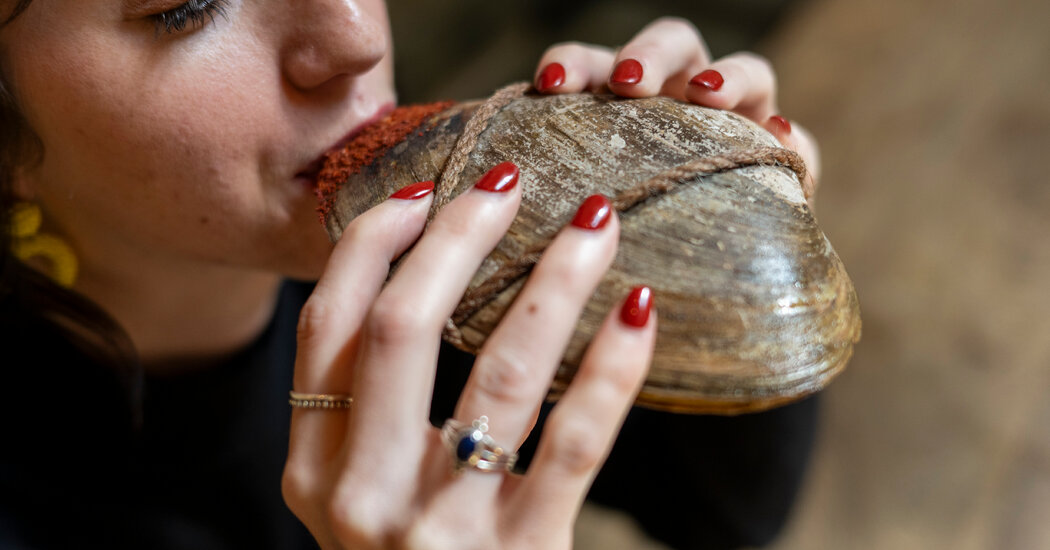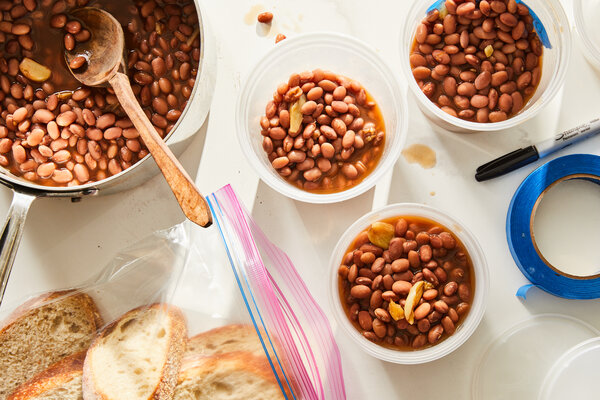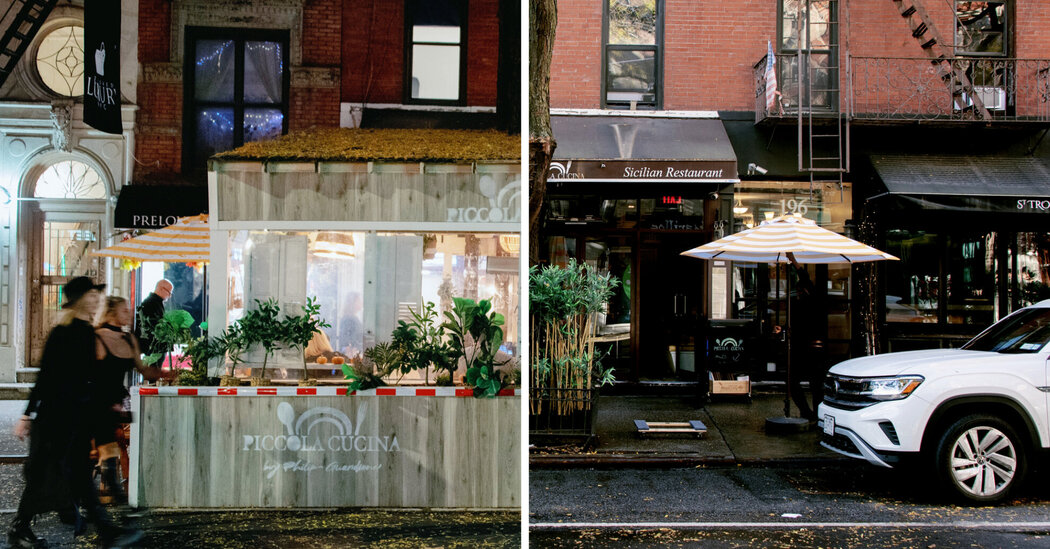The most talked-about dish at ILIS, the cavernous Brooklyn restaurant opened by the Danish-born chef Mads Refslund in October, has to be the clam flask. This is a drinking vessel made by opening a surf clam, removing the clam, resealing the halves of the shell and shearing off a bit of the top lip to create a small opening through which you sip the liquid inside.
When I first had the clam flask, it was filled with a blend of tomato juice and dried-clam broth that tasted something like a virgin Caesar cocktail. The contents, though, are not what has captured everybody’s attention. The reason everybody remembers the flask is that it is tightly bound and knotted with twine, like a corset designed for bivalves with a taste for mild kink.
Mr. Refslund’s cooks must spend a good part of the workweek at the arts-and-crafts station. An Okinawan sweet potato is presented in a fluted tart shell molded from beeswax. Chopped whelk in potato foam is nestled inside the shell and is eaten with a birch stick lashed to an operculum, the part of the whelk that normally seals the shell’s opening and looks something like a guitar pick.
This use of natural materials in the kitchen is one of the hallmarks of the New Nordic style that Mr. Refslund helped found, and the handmade pieces at ILIS have a certain spooky pagan beauty. They cast a spell over all my meals there, a daydreamy state so pleasant that I didn’t want to admit that many of the dishes weren’t really landing the way they should.
A similar spell must have fallen over the writers and influencers who have been talking about ILIS as if it were a New York City branch of Noma. It’s far from that. Mr. Refslund and René Redzepi served as co-chefs of Noma when it opened in 2003 in Copenhagen. After about six months, they agreed that they weren’t cut out to work together, and Mr. Refslund left. He doesn’t try to claim credit for what Noma became, but a lot of people in New York seem eager to give it to him.
The food at ILIS doesn’t resemble any of the dishes I ate at Noma six years ago, each of which pulsed with flavor and originality and was as satisfying as a great pop song or short story. Some of the cooking at ILIS is heading in that direction, but a lot of it tastes wispy and unfinished.
The people comparing ILIS to Noma almost act as if Mr. Refslund and New Nordic cuisine itself were both new to the city. In fact, 12 years ago he was the opening chef of Acme, the restaurant that really did give the city its first taste of the naturalistic, intricate new style. (Not long after, Fredrik Berselius opened the pop-up version of Aska, which has grown into the most impressive local showcase for that cuisine.)
Some items on that menu were forerunners of dishes at ILIS. Ollebrod, a yeasty Danish porridge of dark beer and rye bread, has appeared on the dessert lineup at both restaurants, and so has some version of a granita made from wheatgrass juice.
As he did at Acme, Mr. Refslund builds his menu at ILIS from regional ingredients, but his knowledge of what’s available locally has grown considerably. New Nordic cuisine is less a regional style than a belief system that can be applied almost anywhere. One of its tenets is that we’re surrounded by a vast catalog of wild foods far beyond the small handful of domesticated plants and animals that make up most European and American diets.
In recent weeks the kitchen at ILIS was playing around with blood clams, their hemoglobin-rich juices gathered around them in an alarming red pool; Japanese knotweed, an invasive species that will quickly choke any lot where it takes root but, when picked young enough, tastes tart and fresh; or propeller-like maple seedlings clinging together in purple clusters.
There’s a good chance you’ll run into something new at ILIS, though some of these discoveries are more exciting than others. I was genuinely happy to be introduced, by way of a whole roasted breast and skewers of grilled kofta made from the legs, to the deep flavor of Khaki Campbell ducks, a mallard hybrid that yields leaner and more intensely flavored meat than many other farm-raised ducks. On the other hand, if I don’t gnaw on another raw knotweed shoot until next spring, that will be fine with me.
Each time I ordered sea scallops, servers let me know that they enter the kitchen alive and whole, with their roe. But the sweetness you hope to get from very fresh scallops never quite materialized, whether they were served raw with new spring peas or steamed with dashi and oil made from the roe.
Some courses are almost pure theater. When the sweet potato arrives, a server pours hot beeswax over it and then inverts an hourglass egg timer. This is supposed to signal when the potato is ready to eat, but the heat from a thin coat of wax can’t possibly be strong enough to finish cooking a whole sweet potato. Once this ritual is over, the potato is sliced in half and a big lump of caviar is dropped on one half. You’re supposed to eat the other half with salt. Salt and caviar will make almost any potato taste good, and this one is unusually creamy, its purple flesh as dense and soft as a ripe nectarine, but the jazz-hands presentation oversells it.
Then there is the whole cauliflower brought to the table in the pig’s bladder in which it is cooked. This is a version of a famous French chicken dish, an early method of sous-vide cooking that uses the bladder to seal in moisture so the chicken steams in its own juices. Cauliflower doesn’t have juices, though. Mr. Refslund adds a seaweed stock to the bladder for seasoning and then spoons herb vinaigrette over the florets, but when the bladder is carried to your table and snipped open with scissors, what comes out still tastes like steamed cauliflower.
It’s true that ILIS has served me some of the most memorable dishes I’ve eaten in a long time. I was kind of blown away by the bigeye tuna loin cured in seaweed and salt for months and then sliced thin like aged ham, which the fish resembles in its vivid pink color and focused intensity. I am fascinated by the exceptionally silky raw-milk cheese that the kitchen makes each day and accented one night with shaved asparagus and pickled lily bulbs. And many of the things that came off the grill were riveting, including the sea bream brushed with black-olive sauce and Texas antelope speared on a stick with wild-boar lardo.
With a dish like that in your hands, you can believe that you really are in one of the best new restaurants of the past year. Then you find yourself wondering why the liquid in the clam flask is tepid, even though it’s served on ice; why the scallops aren’t as sweet as they could be; why the brussels sprouts that accompany grilled brown trout are so weird and gloppy.
ILIS isn’t the American Noma, and it’s not meant to be. It could become something important, though, if the cooking ever gets to be as dramatic as the stagecraft.
Follow New York Times Cooking on Instagram, Facebook, YouTube, TikTok and Pinterest. Get regular updates from New York Times Cooking, with recipe suggestions, cooking tips and shopping advice.







